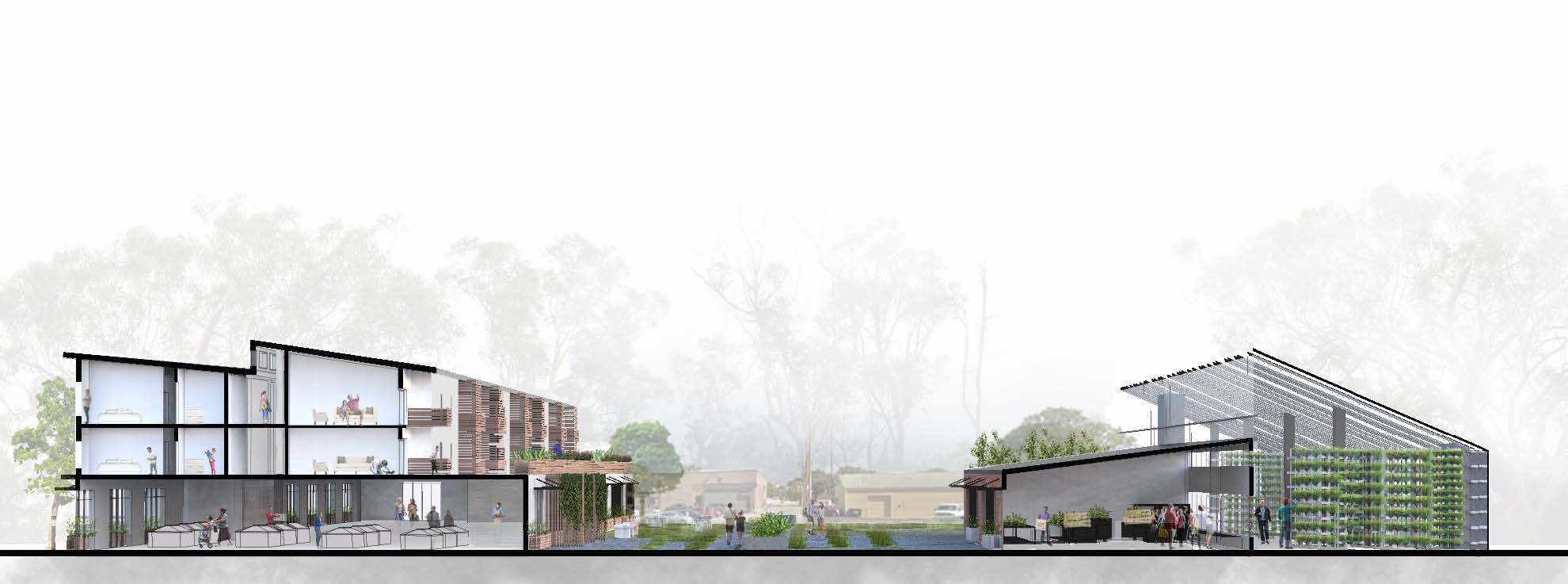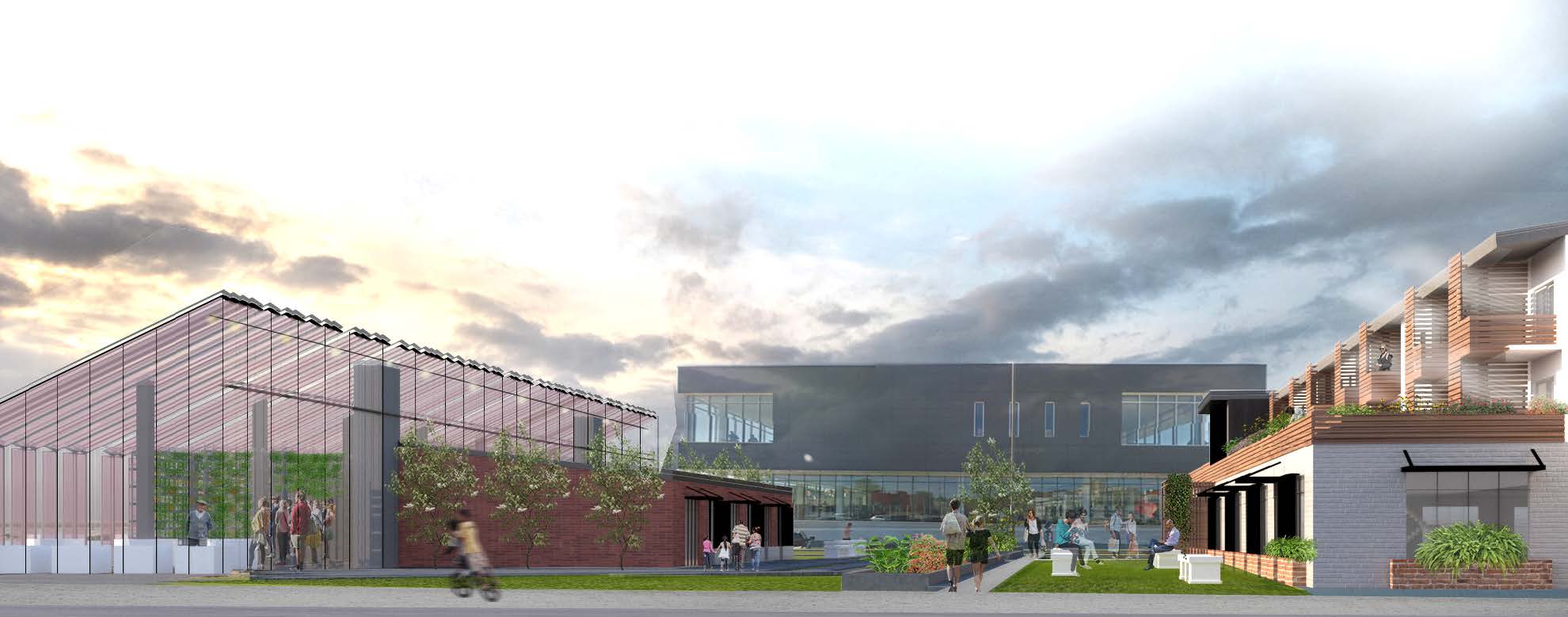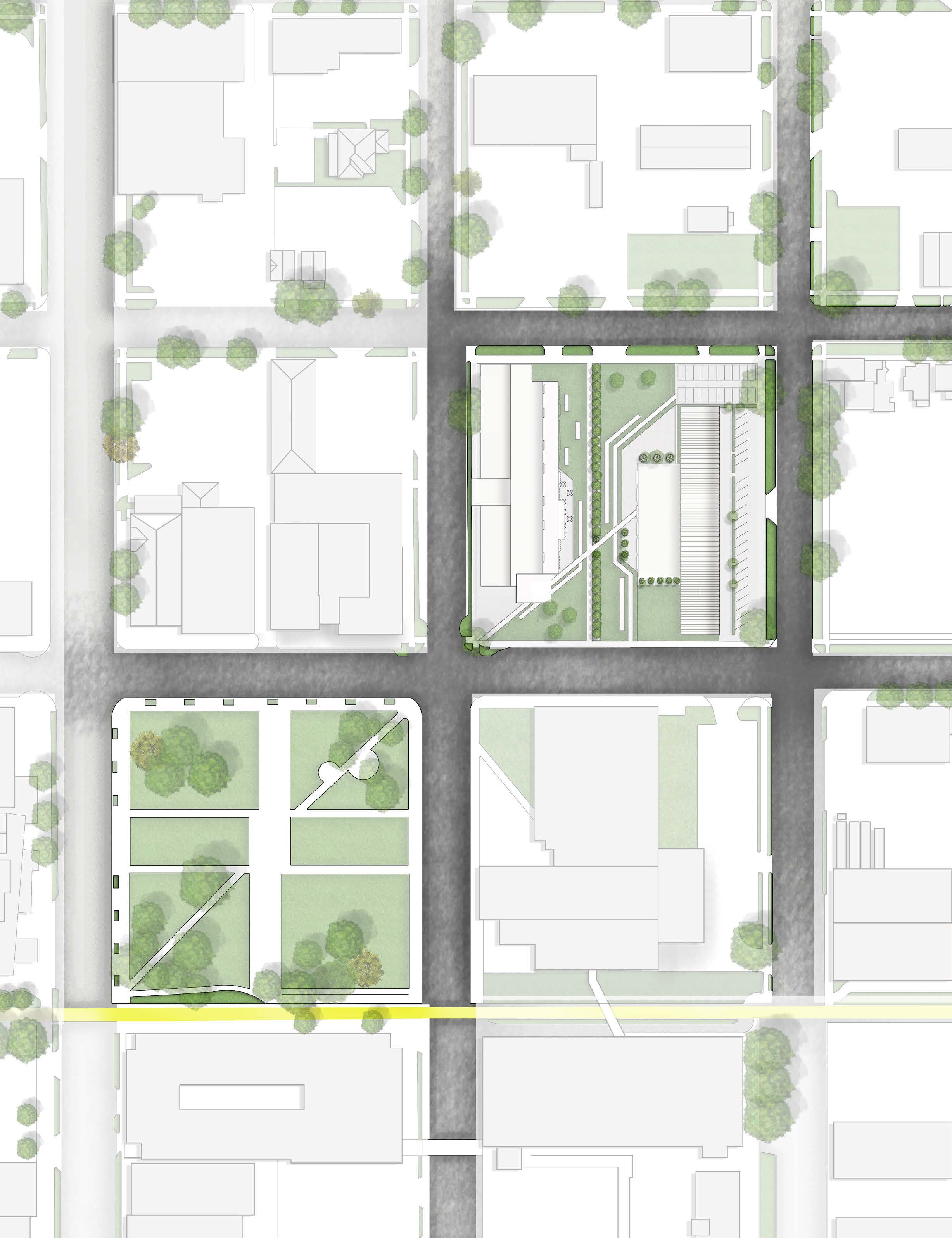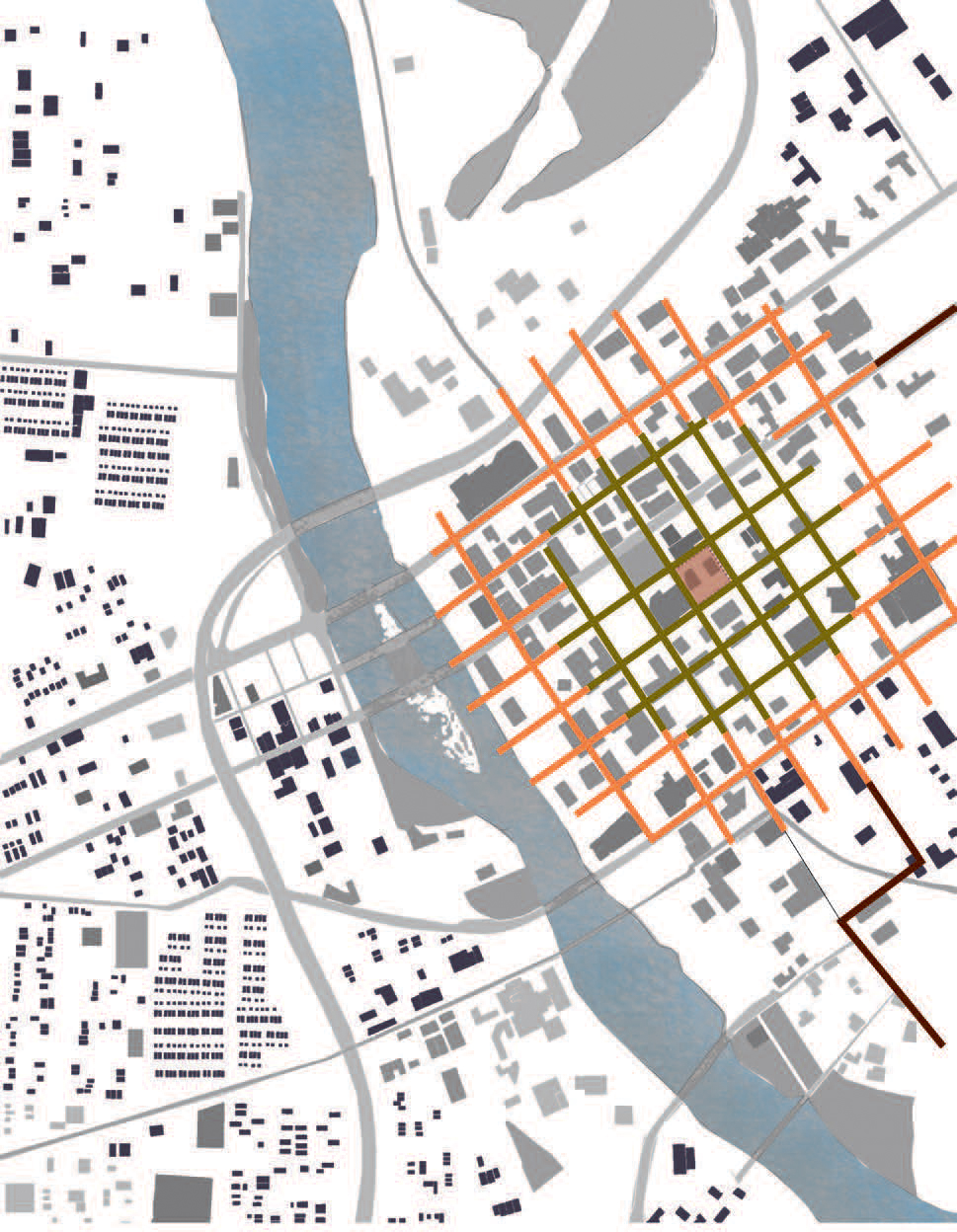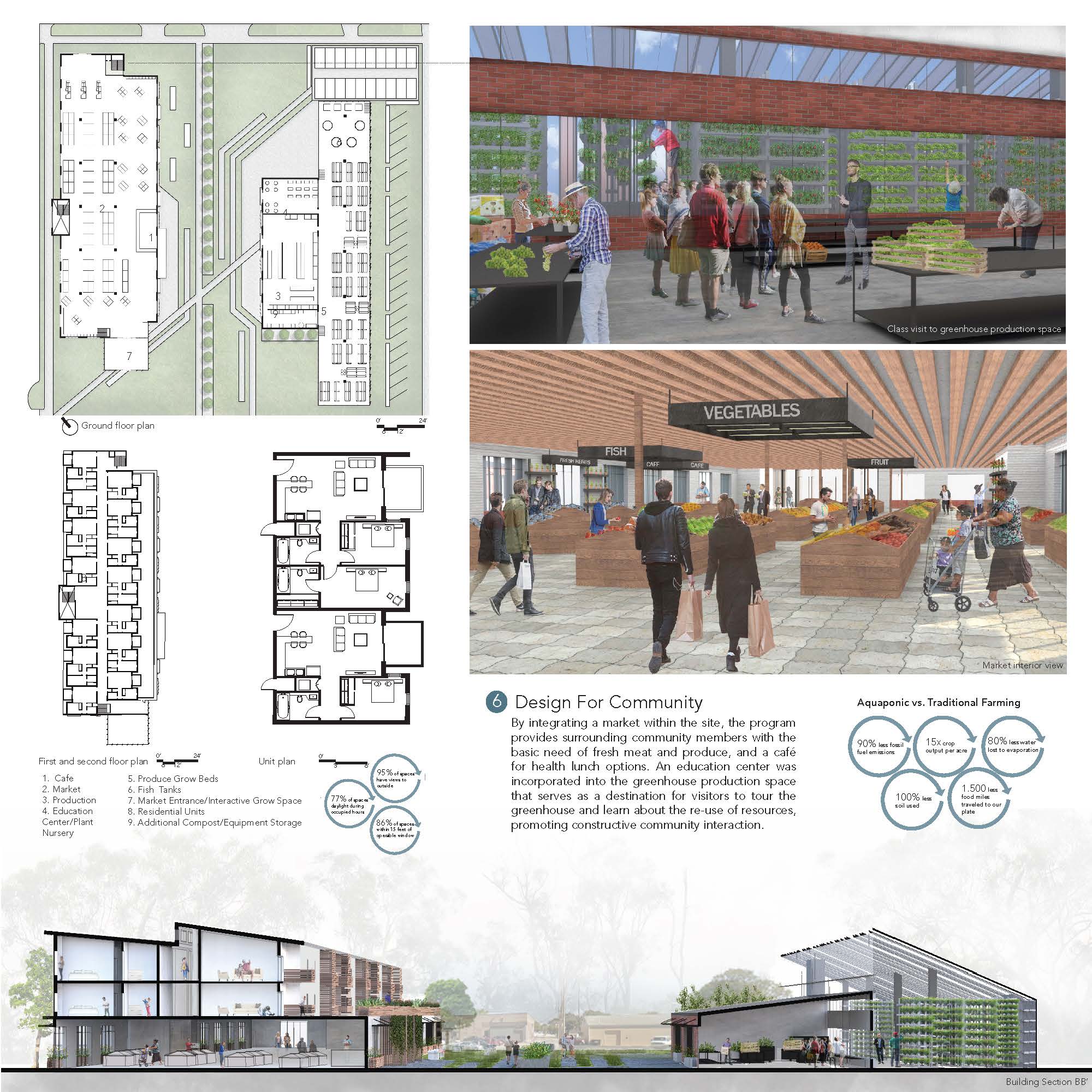ROOT[ED]
Erin Copeland
Himali Limbad
Second year MARCH studio
Instructor: Ulrike Passe
2017
Integration
The increased demand from a growing population is intensifying the pressures on our ecosystems and natural resources. It has forced us to alter our traditional farming techniques to practices that use nitrogen-based fertilizers to increase crop yields. Iowa, who devotes 89% of its land to farming now suffers from water quality standards and irrecoverable soil depletion rates due to chemical runoff. If we continue down this path, Iowa’s soil will become unusable, and the state’s water undrinkable.
Rooted introduces interventions in the system for managing resource resiliency by incorporating an aquaponics greenhouse, production center, market, and residential units within downtown Cedar Rapids, Iowa. A bioswale system was integrated into the existing alleyway and serves as crossover spaces for the otherwise singular resources systems to feedback into one another. This design inserts a closed loop system into an urban fabric that allows Iowa to maintain its rank as a top farming state while also reducing its impact on the environment; not only that, but it also addresses a basic need for surrounding community members.
Community
Downtown Cedar Rapids currently serves as the workplace for over 50,000 community members. Despite this, there are no markets within a mile radius of downtown. By designing a market on the site, the program provides community members with an unmet need as well as a café for healthy options. An education center was incorporated into the greenhouse production space that serves as a destination for visitors. Visitors can tour the greenhouse, learning about the re-use of resources. This interface promotes constructive community interaction.
Ecology
Iowa, whose land was once dominated by lush prairie, has witnessed a dramatic change as it’s natural flora continues to be replaced by towns, highways and farmland. This shift has almost eradicated the once dominant prairie and presents a danger to rare and endangered species. Rooted seeks to restore native prairie by incorporating flora and fauna into the courtyard landscape of the buildings site. Butterfly milkweed, rush aster, and buffalo grass are just a few of the plants that make up Iowa’s endangered habitat list to which we’ve chosen to integrate into our landscape design.
Water
By 2030, 1.8 billion people will experience absolute water scarcity. Our design is heavily focused on restoring Iowa’s water supply by incorporating an aquaponic farming system. Aquaponics uses 70-95% less water than traditional farming systems by eliminating the amount absorbed into the ground. Further, our design saves water by recycling grey water from the apartment units to the grow beds. Unlike traditional farming, aquaponics gets its water from below, which allows the system to reuse grey water as it doesnt come in contact with the edible part of the plant.
Economy
The design reduces initial construction costs by maintaining the existing buildings in the overall design and reusing materials from the deconstructed buildings. The greenhouse-market connection promotes low long term operational costs by eliminating the need for product transport. The design also promotes occupant health by providing healthy fruits, vegetables and vital proteins from fish, leading to lower absenteeism in the workplace and lower health care costs.
Energy
Our buildings were constructed using concrete structural panels designed to eliminate thermal bridging and reduce the need for active cooling systems. The R-48 walls keeps the interiors comfortably tempered despite the drastic fluctuations in Iowa’s climate. Where energy is needed, dye-sensitized solar panels were fixed on the vertical and horizontal building facades to offset any energy used. Scavenger heat from the market refrigerators and aerobic heat from the greenhouse compost allowed contribution to the thermal heating system.
Wellness
Cedar Rapids has several large industrial plants within its downtown that contribute to the city’s poor air quality. By dedicating over 35% of our site to ecology, our greenhouse and landscape work to absorb harmful air polluters through the process of phytoremediation.
Rooted addresses public wellness by providing community members with access to healthy fruits, vegetables, and proteins; options that if used properly can reduce the risk of cardiovascular and other chronic conditions. Occupant health is improved through passive design strategies. 86% percent of the buildings square footage is within fifteen feet of an operable window to improve natural ventilation, while 77% is daylight during occupied hours, eliminating a substantial need for artificial lighting.
Resources
The project has a low carbon footprint as we prioritized the reuse of materials from the deconstructed building. Brick was repurposed as planters that contributed to the building’s aesthetic and thermal mass. Where new materials were needed, we locally sourced timber and concrete to reduce the carbon emissions from production and transportation. Cross-laminated timber was used as a carbon sequestration to additionally offset any incurred emissions. The existing buildings which remain in the final design were reskinned on either the interior or the exterior to create a continuous thermal break and promote efficiency and comfort.
Change
Rooted attempts to not only reduce its impact on the environment but to give back to nature wherever possible. When the heat is extracted from the compost pile and waste reaches the end of its life cycle, there is opportunity for this waste to be shipped out to farms and mixed into the ground to help restore Iowa’s topsoil. The bioswale system allows overflowing water to sweep under the earth beds, recharging the ground water table. Dye-sensitized solar panels provide an unprecedented design that diffuses solar heat gain, converts sunlight to energy, and expedites the photosynthesis process from panels’ red off glow.
Discovery
Rooted tackles population resiliency by converting traditional farming practices to ones that require less resources, doing less harm to our environment. Vertical farming is not a new idea, but the integration of bio-cycles into a closed looped system. Rooted has forced us to research how systems like refrigeration and compost can be utilized as heat sources to reduce the need for artificial systems. We can no longer settle for efficient passive and active systems, but must capitalize on the end cycle of resources and explore how to incorporate them back into the system.

